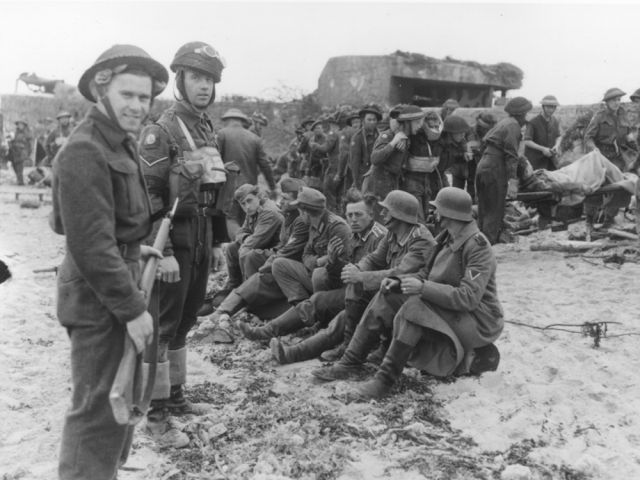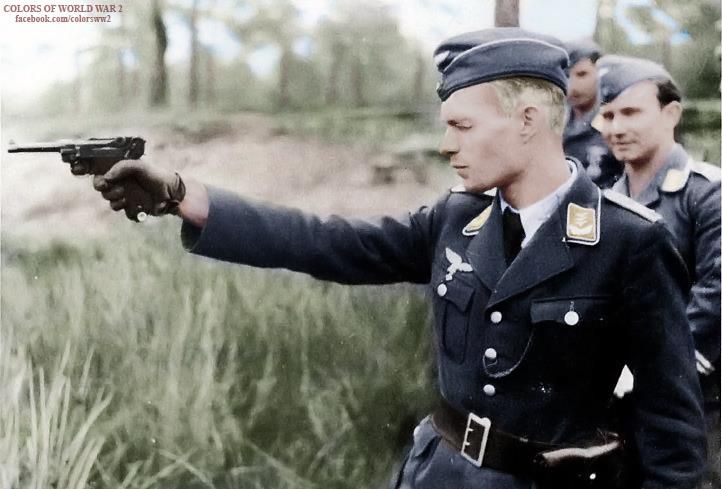
(Canadian soldiers guard German prisoners, June 6 1944. Frank Duberville/National Archives of Canada)
By Stepan Popov
Many aspects of human history and more specifically Canadian history involve firearms. You may not know a lot about Canadian involvement with firearms as it is often overshadowed by our neighbor to the south. Nevertheless, Canadians were engaged in a wide variety of conflicts around the world bringing back firearms as war trophies, developing and producing Canadian firearms and having a long-lasting tradition of firearm ownership going all the way back to the colonization of the Americas. This historical context could explain why Canada is the fifth most gun saturated country per capita. The culmination of a long tradition of firearms ownership and a large number of veteran bring-backs nets a substantial number of historical artefacts that happen to take the shape of firearms. Many of these artifacts are being systematically eliminated as a result of arbitrary gun regulations.
The Case of the P08
The prohibition of the P08 Luger handgun is a great example of regulations greatly inhibiting and, in many cases, prohibiting licensed Canadians from ownership of historical pieces. This prohibition stems from the barrel length restriction of 105mm on all handguns. Many of the handguns that Canadian soldiers brought back from WWII as trophies were the iconic German P08 Lugers. The P08 was very desirable as it was largely used by enemy officers. The vast majority of these have a barrel length of 100mm. By Canadian law, these handguns are 5mm too short to be in the restricted category (a category that any qualifiable Canadian can obtain) and therefore placed in the prohibited category making them almost impossible to purchase, use and transport.

(German Luftwaffe "Airforce" Captain firing a P08 Luger, courtesy of Colors of WW2)
In some very circumstantial cases, these handguns can be passed on to an individual who is licensed and a direct relative of the original owner. While this may seem like a great solution, the reality is that many of the relatives of veterans are not interested in firearms and do not want to go through the complex process of getting a firearms license. This results in the firearm being destroyed or deactivated through very intrusive methods as no one can claim ownership. Deactivation is not only visually unpleasing but also removes a large portion of mechanical knowledge and history from the piece as the working components are no longer operational. Part of what makes firearms interesting is the mechanical knowledge that is transferred through the complexity or simplicity of their internal components.
(Weld marks from deactivation on a P08 Luger)
A simple exemption in the law could have placed the P08 Luger in the restricted category making it available to be purchased and registered by license holders, therefore having its history preserved. The fact that the Luger, a large and heavy handgun, was not exempt in the first place is surprising as the law on short barrels was made to prevent small and concealable handguns from being owned by the public. Unfortunately, there are many examples of historical firearms and their stories being wiped out from history. I would encourage the reader to do their own research on Canadian firearms regulations in order to be better informed on what the current issues with the laws are.
Bibliography:
Civilian ownership of firearms:
Karp, Aaron. “Estimating Global Civilian Held Firearms Numbers.” Small Arms Survey, (2018).
http://www.smallarmssurvey.org/fileadmin/docs/T-Briefing-Papers/SAS-BP-Civilian-Firearms-Numbers.pdf
Canadian law regarding prohibited firearms:
Royal Canadian Mounted Police. “Prohibited Firearms.” April 10, 2017. http://www.rcmp-grc.gc.ca/cfp-pcaf/fs-fd/prohibited-prohibe-eng.htm.
